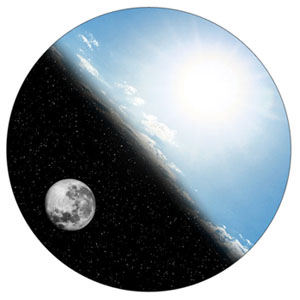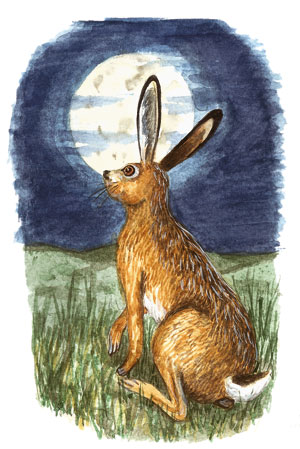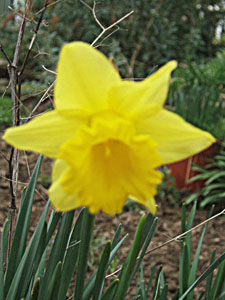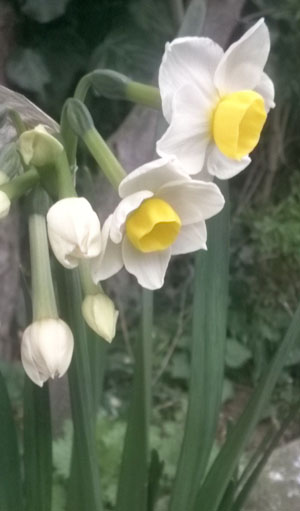Here are Graham's thoughts:

The equinoxes mark the mid points between the solstices, when the length of day time and night time are equal. At the equinoxes, the length of day-time and the progression of the sun along the horizon are changing at their fastest rate.
From Winter Solstice onwards, the days are getting longer, so the Vernal Equinox represents a tipping point, after which the days will start to be longer than the nights. This also marks the entry of the Sun into Aries and can fall anywhere from the 20th to the 23rd (this year it is on the 20 March, at 22:45). This is a theoretical position, though; in fact, the earth wobbles slightly and the atmosphere bends the light from the sun. For these reasons, it's very unlikely that on the Equinox the sun will rise at 6:00am precisely and set at 6:00pm.
A lot of the information on the Wheel comes to us through Christianity, and the Vernal is no exception. This Equinox is a lunar festival about rebirth and renewal. It is also used in calculating the date for Easter. To find the date of Easter, start with Vernal Equinox on a calendar, then go forward until the next full moon, then it will be the Sunday after that. (Roughly, there are exceptions and ecclesiastical full moons!) But this explains why Easter moves from late March all the way into April from year to year.
There are interesting lunar correspondences with Easter. Christ died for three days, then was reborn – moon dark is a period of three days when there is no moon visible in the sky before the new moon. In any year there are either twelve full and thirteen new moons or the other way round, and the Last Supper has traditions associated with the thirteenth guest.This typifies the energy of the festival of reconciling opposites - in this case lunar influences on a solar festival.

This link with the Vernal Equinox also explains why Easter appears to have appropriated two pagan symbols – the Easter Bunny and the Easter Egg. The nearest we can find to an explanation for these is a German Goddess called Eostre. This gets mired in controversy as there is only one historical record of Her – the mediaeval historian the venerable Bede mentioned Her once. In neo-paganism this festival is called Ostara and the symbols of the hare and the egg are attributed to Eostre. But there is no historical evidence for this and Bede himself didn't mention either hares or eggs as being Her symbols.
This discrepancy is usually explained by equating Eostre to other goddesses who have hares and eggs as symbols. However, there are a lot of folk customs attached to the Vernal Equinox from all across lands that were Saxon or Germanic, that involve hares, eggs, dawn and bonfires. From all of this evidence it is fairly certain that there were pre-Christian dawn goddesses in Northern Europe. When Christianity was becoming established it would have taken these rituals and observances and incorporated them into Easter. I would also be comfortable projecting further back and assuming that there was a pre-historic Spring festival around the Vernal that celebrates a dawn Goddess. But, over thousands of years, God-forms can be fluid, their names can change and they can be amalgamated together. Linguistically, for instance, there could be a correspondence between Eostre and the Persian goddess Ishtar or Astarte.

The traditional folk symbols for Easter therefore are reclaimed as the pagan ones for the Vernal Equinox. Moon gazing hares particularly are good symbols and can often be found in garden centres as statues or garden ornaments. Likewise any pictures or other representations can be used to decorate an altar. Easter eggs, either real hard boiled or the chocolate variety, are very good as well. If you are creative or have children, decorating eggs with dyes, or painting them or even making your own chocolate eggs are all fun activities.
In our family this creates some confusion because we celebrate the Vernal, and then realise the rest of the world is still waiting weeks for Easter! There is a folk custom that after the Vernal you can throw your egg shells in a fast moving river to get good luck and fertility in the coming year.
Vernal Equinox is when the sun is moving fastest, but it is also a time of balance. Day and night are equal, yet there is much change. It is a single point of stillness among the movement, like a tipping point. There are, broadly speaking, three Spring festivals and this is the middle one. The energy that lay dormant under the earth at Winter and awoke at Imbolc now gets ready to burst forth through at the Vernal. So this is a festival with a big upswing of energy, about reconciling opposites, like day and night, sun and moon, and using their opposing energy to move things forward.
The Vernal Equinox is about the dawn, about the returning of the light, about greenery and growth. If you assign the festivals to a compass, fairly obviously, Winter belongs to the north and Summer to the south. Attributing the festivals clockwise around the compass puts Vernal Equinox in the east, which works out perfectly since it's associated with dawn Goddesses.
Thinking about prehistoric life, at this time of year animals start having young, the woods are full of flowers and edible leaves, and the days are longer and warmer. After the long cold of Winter, hope has returned to the land.
Food for this festival is all therefore about fresh spring greens and salads. For Easter, lamb is traditional, but in reality, this is New Zealand lamb as English lambs would only just be born if they're being raised naturally. (Lamb is usually around six months old and at least six weeks old, so not available in early farming at this time.) We usually have a chicken salad where we cook the chicken with some light flavouring like herbs and lemon and then toss the meat with the salad. Much more traditional and more likely to have survived from pre-Christian times is the idea of Simnal Cake. This is a cake decorated with twelve or thirteen marzipan balls and sandwiched with marzipan.
Traditional colours for Vernal are yellows and greens, but pale, spring-like tones such as grass green and primrose yellow. In terms of symbolic plants, all spring flowers, especially wild ones or meadow flowers, correspond with the Vernal, as well as gorse and sycamore.
The community aspect to this festival today is likely to be an Easter Egg hunt. This does feel as if it is a traditional activity, bringing everyone together. However, it's up to you how you feel about attending what's likely to be a Christian event for pagan reasons. Secondly, as an Easter event, it's likely to happen around two weeks to a month later than the actual equinox. But it can be a fun thing to arrange privately or with other pagan families. As with all the festivals, it's associated with getting together, lighting fires (or candles) and feasting.
So, that's Vernal Equinox – a bright, happy festival of spring, returning fertility and growth.
And here are Jan's thoughts:

The four major Solar festivals as I know them are those that work in the northern hemisphere. Our comrades on the other side of the world would see these “the other way around” because the festivals are keyed to natural growth cycles in Nature and our planet. Consequently when we are celebrating the Vernal Equinox, Australians (for example) are moving into Autumn, which properly belongs to the Autumnal Equinox. But because my experience of this Festival is from a British point of view, that’s what I will be speaking about here.
This Festival traditionally occurs on the 24 hours following the Sun entering the Sign of Aries – this year that happens at 22.46 GMT on the 20th. Therefore we will celebrate on the 21st. Also commonly over here the official fixed “start of Spring” happens on this same date which causes no end of confusion for people who don’t know the astrological “pinning” of the Festival.
The four “big” ceremonials of the year – the Equinoxes and Solstices – can be heralded over the seven days preceding them (so long as these fall on a rising moon – that is, between New and Full). This is something the whole family can become involved in. For example you can build an ivy wreath which you decorate with spring flower heads. Or, to continue the planting theme from Lights, you might want to start some of your vegetable seedlings off now in a propagator. You could make seed packets as gifts for friends, as an original “Easter” greeting.
Or how about selecting a specific plant in the garden (or one growing in a pot if you are a flat-dweller) and using this to teach yourself and your children something about the inexorable miracle of nature? Study it carefully on the first day, paying attention to everything you see. On each subsequent day, make a point of studying that plant again very carefully and seeing what changes you can notice. Bulbs planted around the Winter Solstice will work nicely here – for example winter planted hyacinths should be popping their flowers at this time of year. But remember, at this time of year supermarkets are dripping with bowls of bulbs, so even if this is your first year of trying this, you can find a decent display to watch over.
There is some interesting lore about eggs you might like to explore around the Vernal Equinox.. For example, bury an egg at the entrance to your property to ensure all visitors are fertile of mind, and full of well wishes. Or try blowing an egg, painting it with the colours of the season, threading it carefully onto green cotton or silk, and hanging it somewhere in your house to ensure continuous rebirth right the way through to next Vernal.
It is around now that my herbs, planted at Lights, are getting strong enough to be potted on, and for me to begin the hardening off process. I usually do all this just before the Vernal. Of course, I have to keep an eye on the weather – but that is all part of the fun, and the glory that is the Vernal Equinox.

The ceremony itself sports a vernal green altar, almost covered with daffodils and narcissi. Especially featured are the blossoms of the hawthorn, ornamental, cherry or apple. Under normal circumstances, we call upon Hat-Hor, archetypal Mother Goddess (though I have to say she has some interesting and more dark sides to her remarkable personality). Everything here is about the re-awakening of the land, the surging and undeniable power of the Spring and its call to Nature to do her best. It is usually a joyous and fulfilling working, redolent with vibrant energy, positively vibrating with power.
We like to eat very fresh young vegetables and leaves afterward so salads are important. This is often a vegetarian feast – but not always. It depends whether local new season lamb is available – this is rare, but when Spring has visited very early it happens at times.
Oh – and we make a point of having Hot Cross Buns, mostly because they are delicious toasted and dripping with butter…but also because that cross is equal-armed – the symbol of the Solstices, crossed by the Equinoxes, or of course, the Elements.
It’s interesting to note that these four “major” festivals tend to resonate for a full 24 hours before we actually get to celebrating them. And we all enter into that energy – most particularly because we know very well that the Celebration of Love’s culmination is on the horizon – much more about this very soon.
Graham has done a fantastic job of covering the links between Easter and Ostara, so I’ll not go there, except to point out that most pagans see the Vernal Equinox as the rebirth of Nature….I suppose that is quite similar in some ways to the concepts behind the Resurrection.

Naturally, the Vernal is a day of balance – day and night are in perfect equilibrium. That aids us in creating balance within. Take some time out on this day to consider those things which have destabilised you in the last year. Try not to attribute emotions to them – rather stand back, and simply let your thoughts and feelings flow. When you feel you have considered thoroughly anything you have disquiet about, make for it a mental image which encapsulates it in your mind. It really does not matter what this is. It just needs to sum up the totality of the issue.
I find eggs very handy for this – you need an egg and a bowl, plus a lot of kitchen towel. But you could do anything else so long as you are able, in one way or another, to “break” the image. I do this by sitting quietly, egg in hand, contemplating my “issue”. And when I have finished, I crush that egg (best done over the bowl ;-)). I take great delight in squadging everything up thoroughly, and knowing I am squadging that issue right out of my life, leaving myself fallow and open for new planting. You could sketch the image and then joyously rip it into shreds. You could write bits of how you feel and set fire to it (fireproof bowl with water required here). You’d be surprised how efficiently you get rid of troubling issues in this fashion.
The Vernal Equinox is all about explosive and positive growth. So…grow!
